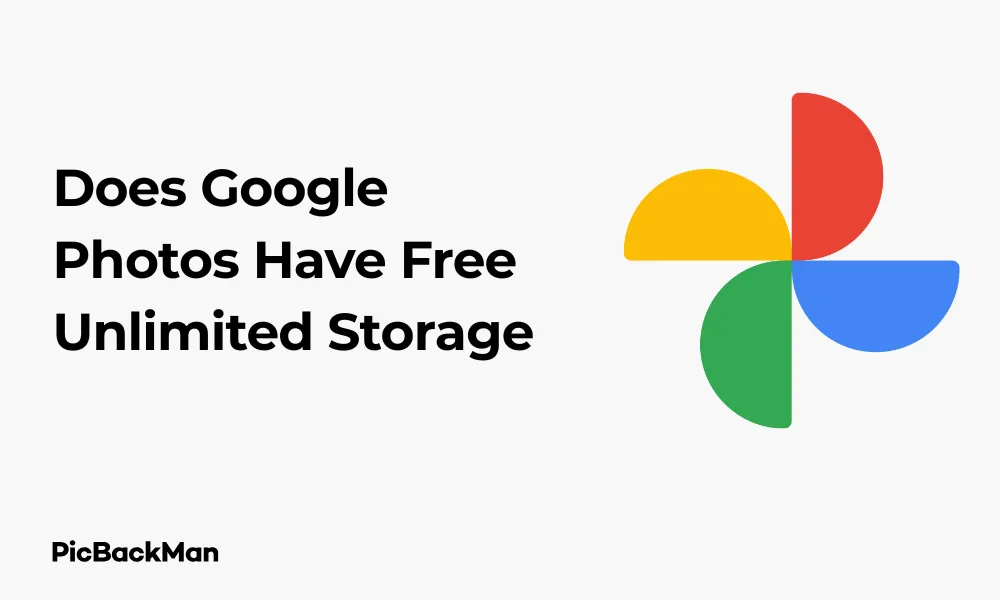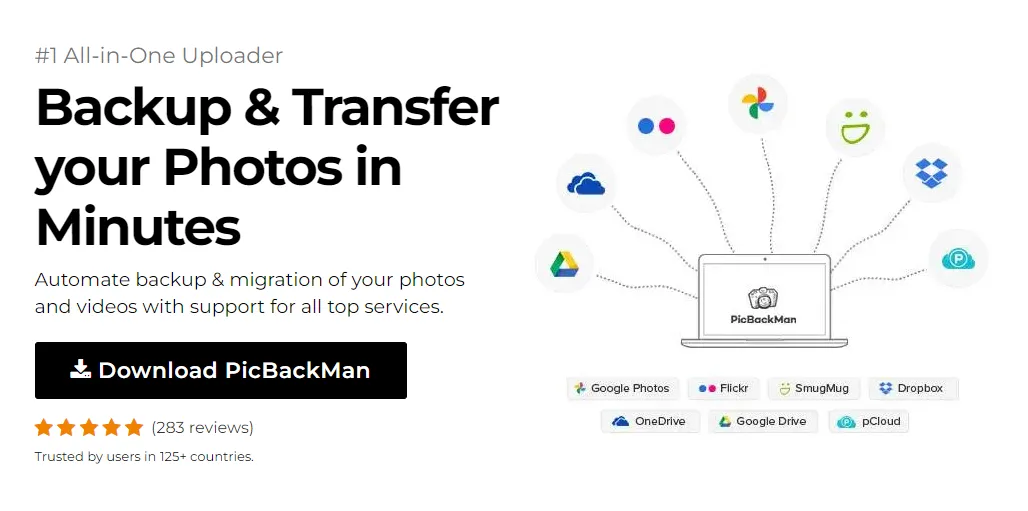
Why is it the #1 bulk uploader?
- Insanely fast!
- Maintains folder structure.
- 100% automated upload.
- Supports RAW files.
- Privacy default.
How can you get started?
Download PicBackMan and start free, then upgrade to annual or lifetime plan as per your needs. Join 100,000+ users who trust PicBackMan for keeping their precious memories safe in multiple online accounts.
“Your pictures are scattered. PicBackMan helps you bring order to your digital memories.”
Does Google Photos Have Free Unlimited Storage


If you've been using Google Photos to store your precious memories, you might be wondering about its storage policy. The question "Does Google Photos have free unlimited storage?" is common among users trying to manage their digital photo collections effectively. In this comprehensive guide, I'll break down everything you need to know about Google Photos storage policies, limitations, and alternatives.
The Current State of Google Photos Storage
Let's cut to the chase: No, Google Photos no longer offers free unlimited storage as of June 1, 2021. This marks a significant change from its previous policy, which allowed users to back up unlimited photos and videos at "High Quality" (now called "Storage Saver") without counting against their Google account storage quota.
What Changed with Google Photos Storage?
Prior to June 2021, Google Photos was incredibly generous with its storage options. Users could upload unlimited photos and videos at slightly compressed quality without using any of their Google account's 15GB free storage. This made it a go-to solution for many people looking to preserve their memories without paying for cloud storage.
However, Google announced a major policy change in November 2020, which took effect on June 1, 2021. Under the new policy, all new photos and videos uploaded to Google Photos count toward your Google account's 15GB free storage quota, which is shared across Gmail, Google Drive, and Google Photos.
What Happened to Photos Uploaded Before June 2021?
Here's some good news if you've been a long-time Google Photos user: Photos and videos uploaded before June 1, 2021, are grandfathered in. This means they don't count toward your storage quota, regardless of the quality setting you chose when uploading them.
This grandfather clause provides some relief for existing users who had already built extensive photo libraries within the service. Your old memories remain "free" in terms of storage allocation, but anything new will start counting against your quota.
Storage Options Available Now for Google Photos
Currently, Google Photos offers these storage arrangements:
- Free 15GB storage: Shared across Gmail, Google Drive, and Google Photos
- Google One subscription plans: Paid storage expansion options
Let's look at each option in more detail.
The Free 15GB Storage Allocation
Every Google account comes with 15GB of free storage shared across Google's main services. This means your emails, documents, and now photos all draw from the same storage pool. For many casual users, this might be enough, especially if you don't store many large files in Gmail or Drive.
However, photos and videos can quickly consume this space, particularly if you're taking high-resolution images or 4K videos with modern smartphones.
Google One Subscription Plans
When your free 15GB runs out, you'll need to consider a Google One subscription. Here's a breakdown of the current plans:
| Plan | Storage Space | Approximate Monthly Cost | Approximate Annual Cost |
|---|---|---|---|
| Basic | 100GB | $1.99 | $19.99 |
| Standard | 200GB | $2.99 | $29.99 |
| Premium | 2TB | $9.99 | $99.99 |
| Higher tiers | 5TB, 10TB, 20TB, 30TB | $24.99 - $149.99 | $249.99 - $1,499.99 |
These plans not only increase your storage capacity but also include additional benefits like access to Google experts, the option to add family members, and extra features for other Google services.
How Quickly Will You Fill Up the Free 15GB?
The rate at which you'll consume your free 15GB depends on several factors:
- How many photos and videos you take
- The resolution of your camera
- Whether you shoot in RAW format
- How much you use Gmail and Google Drive
For context, here's an approximate calculation:
- Average smartphone photo: 3-5MB
- 1-minute 1080p video: 40-50MB
- 1-minute 4K video: 150-400MB
At these sizes, your 15GB could hold:
- 3,000-5,000 photos, or
- 300-375 minutes of 1080p video, or
- 37-100 minutes of 4K video
Of course, this assumes you're using your entire 15GB just for photos and videos, which isn't realistic if you also use Gmail and Google Drive.
Storage Saver vs. Original Quality
Google Photos offers two quality options for uploads:
- Storage Saver (previously called "High Quality"): Compresses photos to 16MP and videos to 1080p
- Original Quality: Keeps your photos and videos at their original resolution and quality
Both options now count against your storage quota, but Storage Saver will use less space, allowing you to store more images and videos within your limit.
Special Cases: Pixel Phone Users
Google Pixel phone users have some special privileges when it comes to Google Photos storage, though these vary by model:
Pixel Models and Their Storage Benefits
| Pixel Model | Storage Benefit | Duration |
|---|---|---|
| Original Pixel (2016) | Unlimited Original Quality storage | Lifetime of the device |
| Pixel 2 | Unlimited Original Quality storage | Until January 16, 2021 |
| Pixel 3 | Unlimited Original Quality storage | Until January 31, 2022 |
| Pixel 3a through Pixel 5 | Unlimited Storage Saver quality | Until June 1, 2021 |
| Pixel 6 and newer | No special unlimited storage benefits | N/A |
If you own an original Pixel phone from 2016, you still have the most generous deal – unlimited Original Quality uploads for the lifetime of the device. However, newer Pixel models have progressively reduced benefits, with the latest models having no special storage advantages.
Managing Your Google Photos Storage Effectively
Since unlimited free storage is no longer available, it's important to manage your Google Photos storage wisely. Here are some practical strategies:
1. Check Your Current Storage Usage
Before making any decisions, check how much of your 15GB you're currently using:
- Go to photos.google.com/storage
- Sign in to your Google account
- View your storage breakdown across Google services
This will help you understand how quickly you're using storage and which Google services are taking up the most space.
2. Use Storage Saver Quality
If you're not a professional photographer who needs original resolution files, using Storage Saver quality can significantly reduce the amount of space your photos and videos occupy:
- Open Google Photos
- Click on your profile picture in the top right
- Select "Photos settings"
- Choose "Storage saver" under "Upload size"
3. Regularly Clean Up Unwanted Photos
Google Photos has several features to help you identify photos you might want to delete:
- Blurry photo detection: Finds and suggests removal of out-of-focus images
- Screenshots folder: Makes it easy to bulk-delete screenshots you no longer need
- Large videos: Identifies space-hogging videos
- Backed up items: Shows photos already saved elsewhere
Use the "Free up space" option in the Google Photos app to remove photos that are already backed up from your device.
4. Export and Archive Older Photos
Consider downloading older albums or time periods to external hard drives or other cloud services:
- Select photos you want to export
- Click the three-dot menu and choose "Download"
- Save these to an external drive or alternative backup solution
- Delete them from Google Photos to free up space
Alternatives to Google Photos
If Google's storage limits don't work for you, several alternatives offer different storage policies:
Comparison of Photo Storage Services
| Service | Free Storage | Paid Plans Starting At | Key Features |
|---|---|---|---|
| Amazon Photos | 5GB (Unlimited for Prime members) | Included with Prime ($14.99/month) | Full-resolution storage, family sharing |
| Apple iCloud | 5GB | $0.99/month for 50GB | Deep iOS integration, shared albums |
| Microsoft OneDrive | 5GB | $1.99/month for 100GB | Windows integration, automatic tagging |
| Dropbox | 2GB | $9.99/month for 2TB | Cross-platform, file recovery |
| Flickr | 1,000 photos | $8.25/month for unlimited | Photography community, EXIF preservation |
Amazon Photos
Amazon Photos is particularly attractive for Prime members, who get unlimited full-resolution photo storage (though video is limited to 5GB). This makes it one of the closest alternatives to the old Google Photos unlimited storage model.
Apple iCloud
For iPhone users, iCloud offers seamless integration with iOS devices. While the free 5GB is quite limited, the paid tiers are reasonably priced, especially the 50GB and 200GB options for individual users and families.
Microsoft OneDrive
OneDrive integrates well with Windows devices and offers photo organization features similar to Google Photos. It's a good option if you're already in the Microsoft ecosystem.
Is Google One Worth It for Photo Storage?
Whether Google One is worth paying for depends on your specific needs and usage patterns. Here's a breakdown to help you decide:
Pros of Google One for Photo Storage
- Ecosystem integration: Works seamlessly with Android devices and other Google services
- Powerful search: Google's AI can find specific people, places, and things in your photos
- Editing tools: Built-in editing features that continue to improve
- Memories feature: Automatically creates collections, collages, and animations
- Family sharing: Can share your storage quota with up to five family members
Cons of Google One for Photo Storage
- Ongoing cost: Subscription model means you'll pay indefinitely
- Price increases: Google could raise prices in the future
- Storage shared: Your quota is divided among Photos, Drive, and Gmail
- No unlimited option: Unlike some competitors, there's no unlimited storage tier
Who Should Pay for Google One?
Google One makes the most sense for:
- Heavy Android users who are deeply integrated into the Google ecosystem
- People who value Google Photos' AI-powered organization and search capabilities
- Users who need substantial storage across Google services, not just photos
- Families who can share a single plan across multiple users
Tips to Maximize Your Free Google Photos Storage
If you want to stick with Google Photos but avoid paying, try these strategies:
1. Use Storage Saver Quality Exclusively
Always upload in Storage Saver quality to maximize the number of photos and videos you can store within your 15GB limit.
2. Regularly Delete Unnecessary Content
Make a habit of reviewing and removing:
- Duplicate photos
- Screenshots you no longer need
- Blurry or poor-quality images
- Multiple similar shots of the same subject
3. Manage Gmail and Drive Storage
Since your 15GB is shared across Google services, free up space by:
- Deleting large email attachments
- Emptying your Gmail trash
- Removing unnecessary files from Google Drive
- Converting documents to Google's native formats (which don't count toward storage)
4. Use Google's Storage Management Tool
Google provides a storage management tool that helps identify large files and emails that you might want to delete:
- Go to one.google.com/storage/management
- Review the suggestions for freeing up space
- Delete unnecessary items directly from this interface
The Future of Google Photos Storage
While Google has shown no signs of returning to the unlimited free storage model, the service continues to evolve. Recent developments include:
- Enhanced AI features: More powerful search and organization capabilities
- Improved editing tools: New filters, effects, and AI-powered enhancements
- Better sharing options: More flexible ways to share photos with friends and family
Google continues to invest in making Photos a central part of its ecosystem, suggesting that while free unlimited storage may be gone for good, the service itself will continue to improve in other ways.
Frequently Asked Questions
1. When did Google Photos stop offering free unlimited storage?
Google Photos stopped offering free unlimited storage on June 1, 2021. After this date, all new photos and videos uploaded to the service count toward your Google account's 15GB free storage quota or your paid Google One subscription.
2. What happens to my photos if I exceed the storage limit?
If you exceed your storage limit, you won't be able to upload new photos or videos to Google Photos until you either free up space or upgrade to a paid Google One plan. Your existing content remains accessible, but new content won't sync until storage issues are resolved.
3. Do photos uploaded before June 2021 count toward my storage quota?
No, photos and videos uploaded before June 1, 2021, in "High Quality" (now called Storage Saver) don't count toward your storage quota. They remain exempt from storage limits under Google's grandfather clause for existing content.
4. Is there any way to still get unlimited photo storage with Google?
The only way to get unlimited photo storage with Google now is if you own an original Pixel (2016) phone, which still offers lifetime unlimited original quality uploads. No other current Google product or service offers unlimited photo storage.
5. How do I check how much Google Photos storage I'm using?
To check your Google Photos storage usage, visit photos.google.com/storage or go to one.google.com/storage. These pages show a breakdown of your storage usage across Google Photos, Gmail, and Google Drive, helping you identify where your storage is being used.
Quick Tip to ensure your videos never go missing
Videos are precious memories and all of us never want to lose them to hard disk crashes or missing drives. PicBackMan is the easiest and simplest way to keep your videos safely backed up in one or more online accounts.
Simply download PicBackMan (it's free!), register your account, connect to your online store and tell PicBackMan where your videos are - PicBackMan does the rest, automatically. It bulk uploads all videos and keeps looking for new ones and uploads those too. You don't have to ever touch it.
Conclusion
The simple answer to "Does Google Photos have free unlimited storage?" is no—at least not anymore. Since June 1, 2021, all new uploads to Google Photos count toward your 15GB free storage quota or your paid Google One subscription.
While this change disappointed many users who relied on the service's generous previous policy, Google Photos remains one of the best photo management services available, with powerful organization, search, and editing features that many competitors can't match.
Your best approach depends on your specific needs: casual photographers might find the free 15GB sufficient with careful management, while those with larger collections will need to consider paid Google One plans or alternative services. Whichever route you choose, making an informed decision about your photo storage strategy will help ensure your precious memories remain safe and accessible for years to come.






